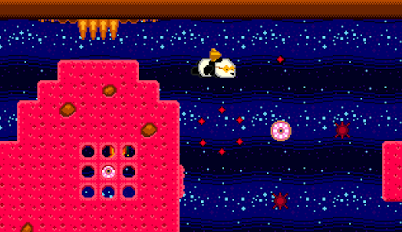The GameObject System
The heart of this Genesis game / engine is the GameObject system. And it doesn't really get much simpler than this. (These aren't Unity GameObjects!)
I have a single list of GOs - each being an area of memory - effectively in a list. They are (sort of) structures. (there are not really any structs or classes in assembler)
These contain the basics which every kind of GO needs. Data like position, velocity, animation frame, flags, etc.
Alongside that they have some space which can contain different data for different types of GOs.
There is no concept of a class hierarchy, each GO is the same from the code's point of view. Having a fixed size structure is an enormous advantage. It keeps things simple, and removes the need to have different sorts of lists for different objects.
For speed when adding / deleting objects I keep lists of pointers. One for GameObjects which are in use, and one for those which are inactive, so this operation always takes a fixed amount of time.
The main loop calls the GameObject Update function, which cycles through the active list, running a piece of code for each object. Similarly, when a new object is made active, it has a few important variables reset, and calls a function to initialize the object.
Here's the code for about the simplest object I can find:
GameObjects are identified by type, which is simply an index. In this case:
GOTYPE_SPIKES so.b 1
And there's also a table which contains the data to initialize a GameObject:
dc.w GOTYPE_SPIKES ,0
dc.l UpdateSpikes,InitSpikes
So, the functions are looked up in the table, using the GOTYPE, and InitSpikes is called. InitSpikes uses a couple of macros to set what sprite and collider that GO is using, while UpdateSpikes (which is called every frame) performs a simple animation loop.
All very simple, but the real beauty is that the code and tables are generated from within the Unity editor when the game is exported. The Init Function will be exported as is shown here, as the collision and sprite are set up with editor tools. The Update function will be empty, so all I need to do there is go in and add whatever code is required.
Here's another slightly more complex example. A proximity mine which explodes when near the player, and generates 6 pieces of shrapnel:
And here you can see Proximity mines placed in a level in the editor. Their trigger zone is shown to more easily plan gameplay segments.





Comments
Post a Comment